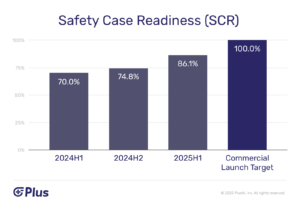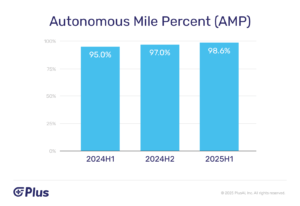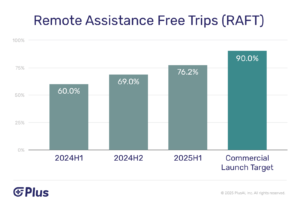PlusAI has released a set of key performance indicators (KPIs) designed to track progress toward the commercial readiness of SuperDrive.
The company has reported that it achieved several advancements autonomous performance metrics in the first half of 2025. These were reaching 86% safety case readiness (SCR), a 98% autonomous miles percentage (AMP) and 76% for remote assistance free trips (RAFT), up from 75%, 97%, and 69%, respectively in the second half of 2024.
As PlusAI transitions to a public company, it says it intends to report these KPIs regularly to provide transparency on its path to commercial launch in Texas in 2027.
For commercial launch, PlusAI is targeting 100% SCR and more than 90% RAFT. The company is currently conducting public road testing in Texas and Sweden, with customer fleet trials scheduled for the autumn of 2025.
“We have a clear roadmap to the commercial launch of SuperDrive,” said David Liu, CEO and co-founder of PlusAI. “By publicly sharing these performance metrics on a regular basis, we’re demonstrating our unwavering commitment to the safe and scalable deployment of factory-built autonomous trucks. We believe it’s essential for partners, customers, regulators and all road users to have visibility into our safety-driven progress and our disciplined approach toward commercializing autonomous driving technology.”
PlusAI has deployed autonomous driving technology across over five million miles of driving in the USA, Europe and Asia, generating a dataset that fuels technology development. Leveraging this data and advanced generative AI models, the company has built a generalizable driving intelligence platform using auto-labelling, model distillation and optimized in-vehicle neural networks.
Safety case readiness
For safety assurance, the company follows the safety case approach used in safety-critical industries. The SCR metric measures how mature and complete the safety case framework (SCF) is to support the safe operation of SuperDrive. 
The safety case approach is structured around five core pillars. Understand establishes the safety foundation through structured analysis, system definition and hazard identification. Design focuses on integrating safety principles, redundancy and fault tolerance into the AV system’s architecture and software. Develop verifies and validates system performance using simulation, bench tests, closed-course and public road testing. Prove measures safety performance through data analysis and continuous improvement of metrics and safety cases. And Deploy ensures safe deployment and maintenance through configuration control, release management and in-field monitoring.
Autonomous miles percentage
To assess the performance of its autonomous system, the company uses the AMP metric. This is defined as the percentage of total distance driven by SuperDrive on a specified route that is completed under full autonomous control, without intervention from a remote operator or onboard safety driver.

AMP tests SuperDrive’s ability to sustain autonomous operation across varying conditions along a commercial corridor and quantifies the reliability of SuperDrive in real-world operations. It also complements the RAFT metric by providing a continuous measure of autonomous engagement across distance traveled.
Remote assistance free trips
RAFT captures the percentage of autonomous trips completed without any intervention from a remote operator or an onboard safety driver on a specified commercial route. A trip is considered RAFT-compliant if SuperDrive maintains full control from departure to arrival, without any human assistance to control the vehicle. While remote assistance will always be available if needed, this metric highlights SuperDrive’s operational independence and technical maturity. 
“Our AV 2.0 architecture marks a major shift in how we design and deliver autonomous driving systems. By replacing hand-written components with end-to-end AI models, we’ve simplified the overall system and accelerated performance improvements. This approach ensures we’ll be ready for broad deployment as soon as our factory-built autonomous trucks begin production in 2027. We’re excited to be at the forefront of autonomous driving technology,” added Tim Daly, chief architect at PlusAI.
In related news, Pony.ai has announced that its Level 4 (L4) automotive-grade autonomous driving (AD) domain controller has surpassed two million kilometers of on-road testing. Read the full story here


